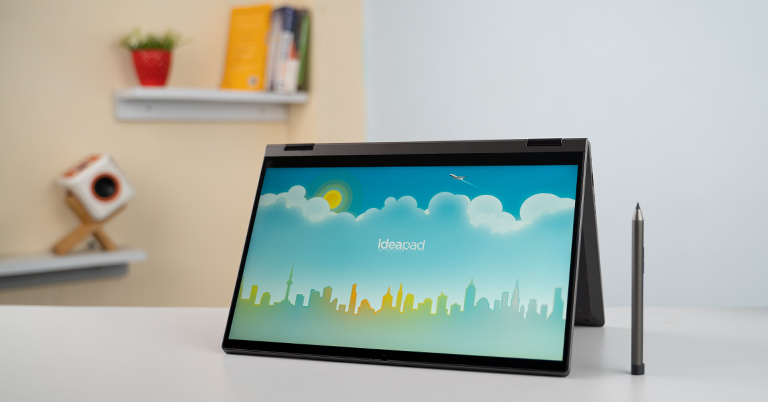
Lenovo recently updated its IdeaPad Flex series of 2-in-1 laptops with the latest processors from AMD. And here I have the 2021 edition of Flex 5 that hosts very few upgrades compared to its predecessor. But that’s not necessarily a bad thing. Let’s learn more about the Lenovo IdeaPad Flex 5 14 in this review.
Lenovo IdeaPad Flex 5 14 Specifications:
- Design & Build: All-plastic build, 12.66W x 8.56D x 0.70H-inches, 1.5 kg
- Display: 14″ glossy IPS panel, 250 nits brightness, 45% NTSC color gamut
- Resolution: FHD (1920×1080) resolution, 16:9 aspect ratio
- Keyboard: Chiclet-style backlit keyboard
- Trackpad: Plastic multi-touch trackpad, Windows Precision drivers
- Processor: AMD Ryzen 5 5500U CPU, Zen 2 (Lucienne), 6C/12T, 4.0GHz Max Boost Frequency, 8MB L3 Cache, 7nm FinFET, 25W TDP-up
- RAM: 16GB DDR4 RAM (3200MHz) (soldered)
- Storage: 256GB M.2 PCIe NVMe SSD (expandable)
- Graphics: 7-core AMD Radeon 7 Graphics @1800MHz (Integrated)
- Audio: 2x 2W speakers with Dolby Audio, Dual microphone
- Battery: 52.5 Watt-hours Li-Ion battery
- Power Supply: 65W USB-C AC power adapter
- Webcam: 720p HD camera, Privacy Shutter
- Connectivity: WiFi 802.11 ax (2×2), Bluetooth 5.0
- I/O Ports: 2x USB 3.1 Gen 1 Type-A, 1x USB 3.1 Gen 1 Type-C (with PD charging), 1x HDMI 1.4b, 1x 3.5mm combo audio jack, 1x 4-in-1 card reader, 1x DC port
- Price in Nepal: Rs. 118,000
- What’s inside the box: Laptop, power adapter, quick start guide, Lenovo Active Pen, AAAA battery
Lenovo IdeaPad Flex 5 14 Review:
Design
- All-plastic build, 2-in-1 convertible
- A relatively flimsy hinge mechanism
Because this is a budget entry in Lenovo’s lineup of convertible laptops, the IdeaPad Flex 5 features an all-plastic build quality. So as far as premium hands-on feel goes, this laptop is not gunning for that title in the first place. The Graphite Grey finish that the device arrives in looks quite good though.
To ensure easy handling, Lenovo has smoothened the bezels all around. Here, the keyboard deck has this relatively rubberized feel contrary to the lid of the laptop. More importantly, neither of them attracts fingerprints or smudges as much. And the ones that do manage to leave a footprint can be easily wiped off.

There are two Lenovo branding inside a metal encasing—one at the back and one on the keyboard chassis. While the rubber feet allow for a pretty firm grip on a flat surface, their height compromises an efficient airflow to the wide intake vents on the bottom. Plus, unlike the “ErgoLift” hinge we see in Asus laptops, Lenovo hasn’t implemented any elevating mechanism either.
Thermals
So, the Flex 5 does get slightly warm mostly on the left half of the chassis with 7-8 Chrome tabs open alongside a couple of other lightweight apps like a word processor and media player running in the background. As far as thermals go, the company has installed a traditional single-fan (right) set up alongside two heatpipes.
I mostly tested the device under the “Intelligent Cooling” profile which is supposedly a middle-ground between max performance and quiet fan noise. Fortunately, under the aforementioned use case (which I’d classify under lightweight – medium), the fan doesn’t kick in as much, thereby delivering a quiet performance. But with keen pair of ears, the faint fan noise is still audible here.
For absolutely inaudible fan noise, there’s the Battery Saving profile which comes at a compromise of CPU performance. Here, the exhaust vent at the back does a fairly good job of blowing the hot air away from the screen as well. However, I have to mention the inconsistency of the thermal performance of this convertible machine.
For some reason, the device starts getting hot even under low CPU-intensive tasks like the one mentioned earlier, with fans failing to bring down the temperature. To reiterate, this is not a routine occurrence and I experienced this in a couple of instances only. Seems to me that this is purely a software issue and Lenovo could easily roll out an update addressing the problem—although that’s yet to arrive.
Moving on, for a 14” laptop, the Flex 5 is quite heavy. At 1.5 kg, it is bulkier than some other 14” laptops we’ve reviewed recently like MSI’s Prestige 14 Evo. This is not to say that you’ll have a hard time carrying it around, absolutely not.
Port selection
Anyway, IdeaPad Flex 5 has a pretty impressive selection of I/O. The left frame houses a DC port, a full-sized HDMI 1.4b, one USB 3.1 Gen 1 Type-C, and a 3.5mm combo audio jack. The Type-C port also supports PowerDelivery and depending on the region, Lenovo ships this laptop with either a barrel charger or a USB-C adapter. In our case, we got the latter
Similarly, the right frame hosts two USB 3.1 Gen 1 Type-A, a 4-in-1 card reader, and the power button. Interestingly, both Type-A ports also support “Always on USB”, meaning you can charge your phones or tablets via the Flex 5 even when it is in sleep mode or completely turned off. But if you find this feature unnecessary, you can simply turn it off on the Lenovo Vantage app.
Display
- 14″ glossy touch IPS LCD panel
- 250 nits, 45% NTSC color space
- Lenovo Active Pen inside the box
As we know by now, the display is one of the key areas where laptop manufacturers find a way to cut costs on their fairly affordable offerings. And unfortunately, that’s what’s happened here as well. Simply put, IdeaPad Flex 5’s 14” screen is disappointing and below average.
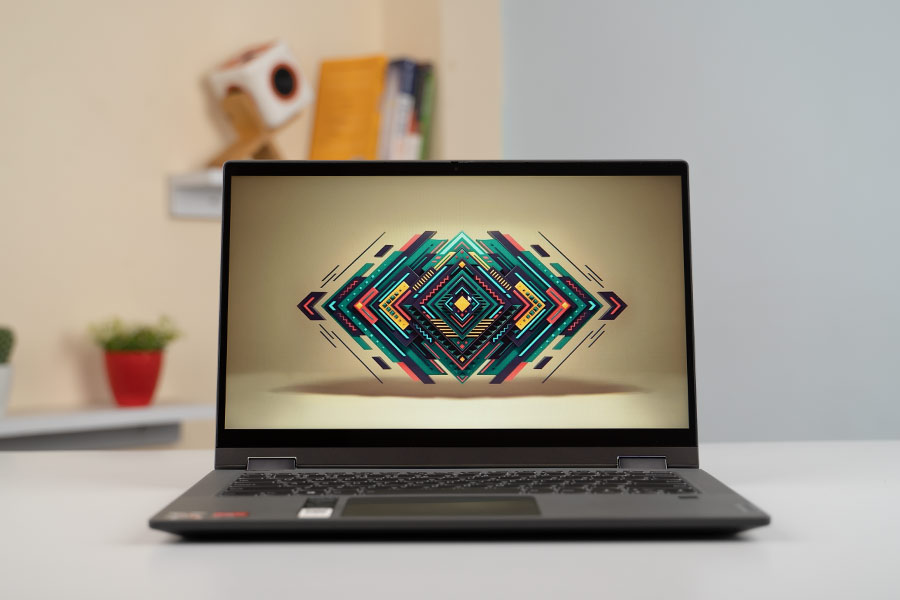
Lenovo lets you choose from two equally underwhelming options: an IPS panel with 250 nits brightness, or a TN panel with 220 nits brightness. On paper, the latter sounds unpassable for everyday usage but the 250 nits option that I have with me isn’t any better either. Even indoors, I’ve had to set its brightness level at around 70% during my everyday usage.
Sub-par brightness
Suffice it to say, you will struggle with outdoor visibility on this laptop. There is a 15” version as the Flex 5 as well but that one maxes out at 250 nits too. I’m getting this déjà vu when I say how it lacks sufficient brightness levels as well.
You see, like the Yoga 7i that we reviewed a couple of months ago, this one’s illumination level fluctuates by quite a big margin with a minimal switch in brightness settings. Unlike me, if you’re someone who favors auto brightness adjustment, it could be a headache.
Besides the sub-par brightness, this is not a vibrant, color-rich display either. No matter which of the three configurations you pick, Lenovo has made things super simple with a uniform 45% NTSC (or around 62% sRGB) color gamut on all options. The colors look pretty flat, especially red and yellow.
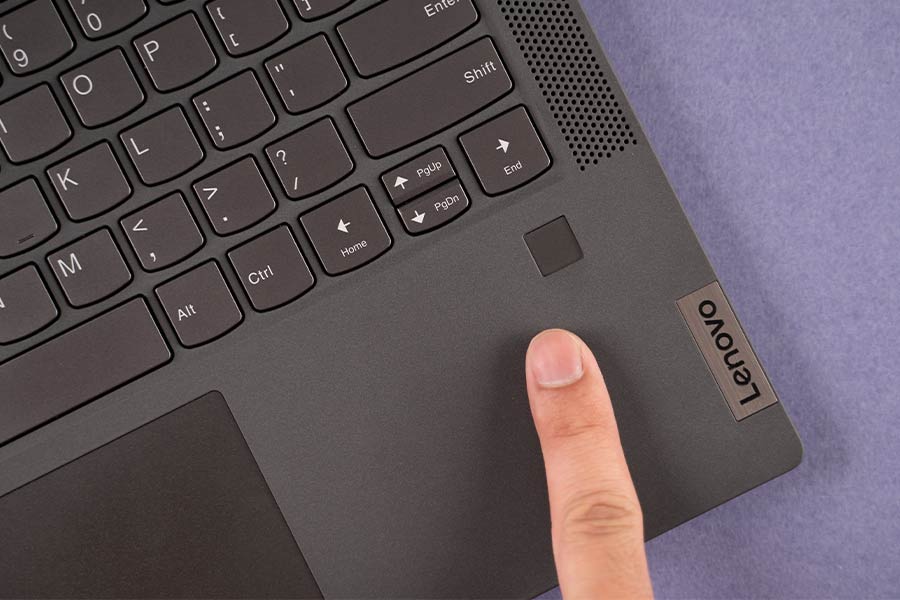
In the default color calibration, the screen has a nominal greenish tint too. Moreover, I noticed mild backlight bleed around the top edge of the display as well. But because this is a 2-in-1 laptop, you can transform it into a tablet at your whim. The touch response is pretty good and more importantly, the company throws a Lenovo Digital Pen inside the box too. This generous combo makes the Flex 5 an appealing choice for students and similar demographics.
Unreliable hinge?
Yet, the hinge isn’t as sturdy all-around since it is noticeably flimsy in the 60-90º ballpark. Apart from tablet and laptop mode, you can use it under Tent and Stand formation as well. Inside the built-in Alexa app, there’s also something called “Show Mode” which effectively turns the laptop into an Amazon Echo Show device although the functionalities are quite limited.
Anyway, this glossy screen isn’t ideal when you’re in a room with multiple light sources either. The Lenovo Flex 5 still adheres to the 16:9 aspect ratio with a big bottom chin while the bezels on the remaining three sides are fairly minimal. Plus, it attracts dust particles quite easily too.
Keyboard
- Backlit chiclet-style keyboard (single-color)
Moving on, its keyboard is just good enough for a starter laptop. These concave-shaped keys with plastic keycaps feel quite cheap while still being a decent typer. They have a fairly silent audio profile yet the Shift, Enter, and Backspace keys rattle by quite a bit.
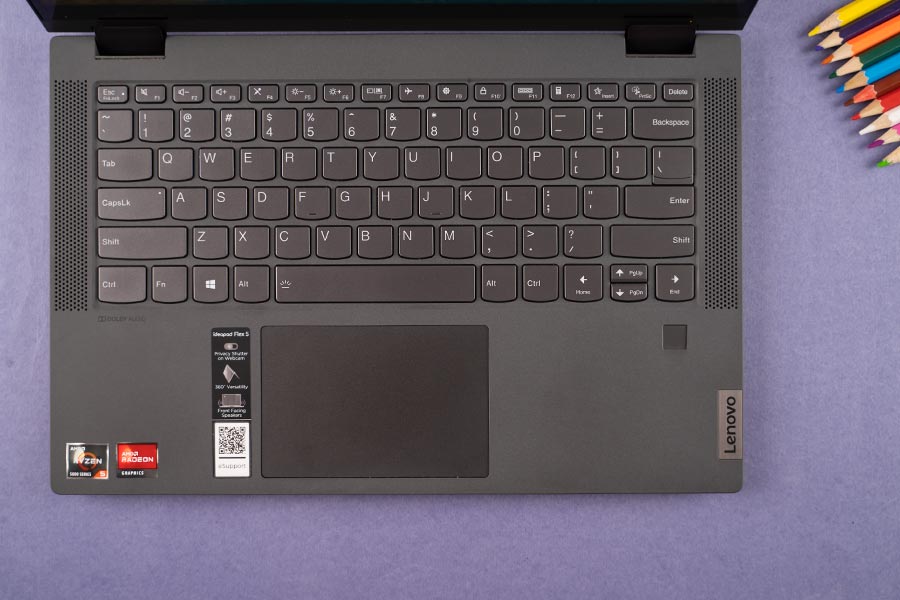
Regardless, the keys are well spaced out and I’ve had no trouble maintaining my usual typing speed here. It is also backlit with two levels of illumination to choose from. I found the lowest brightness setting to be inadequate under dimly lit rooms.
Also, I did notice the keyboard backlight bleed mostly from the number keys which is a little distracting when looking at the laptop by positioning it at eye level. Thankfully, the keyboard deck doesn’t flex as much and the Function keys hold handy shortcuts. Still, the microphone toggle and the user-programmable ‘S’ key don’t seem to work.
You can lock the Function key as well—which has a dedicated LED indicator to denote its status. The up/down keys share one standard keyspace while the entire directional keys integrate Home, End, PgUp, and PgDn shortcuts too. In terms of security, the Lenovo Flex 5 has a Windows Hello-certified fingerprint reader down the right arrow key which is fairly responsive and fast.
Trackpad
- Plastic trackpad with integrated left/right keys
Likewise, this plastic trackpad is nothing to write home about either. I would’ve preferred a centered layout but Lenovo has favored placing it slightly to the left instead. Despite this, I’ve had no issue regarding accidental touches here.
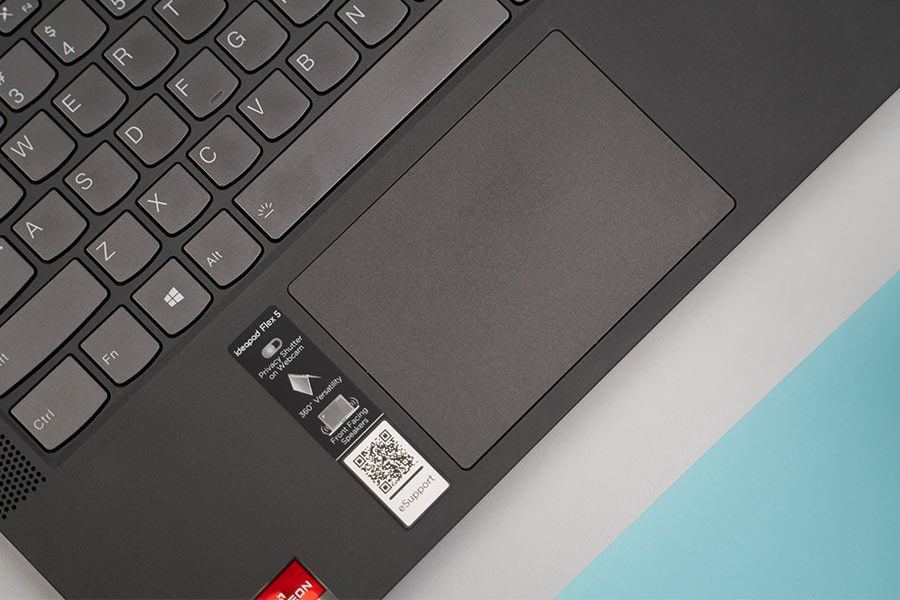
As expected, it comes with Windows Precision drivers so gestures work perfectly fine too. The integrated left/right keys are quite loud and the trackpad itself is prone to mild flex upon press as well. Thankfully, it doesn’t attract many fingerprints or smudges.
Webcam
- 720p HD webcam, Privacy Shutter
A physical privacy shutter has become a staple of Lenovo laptops and fortunately, the IdeaPad Flex 5 keeps this tradition alive. You can push the switch to either side to block or unblock the camera. When disabled, you’ll see a small red dot over the camera. Anyway, the camera quality itself is pretty decent although, at times, it fails to lock focus.
The subjects look soft with muted colors but that’s passable for your video calling needs. For a budget laptop, I can’t complain about the audio pickup from the array microphone either. To note, the laptop doesn’t have IR cameras—meaning it doesn’t support Windows Hello face authentication.
Audio
- 2x 2W front-firing speaker setup
- Dolby Atmos, dual microphones
Coming to the audio side of things, there’s a front-firing Dolby Audio stereo speaker setup that pumps out sufficiently good sound quality through the grills on either side of the keyboard deck. Weirdly enough, the audio output radius isn’t as wide as the speaker grill itself. Instead, (roughly) the upper half solely serves as symmetric design choice only.

Even at max volume, there is no distortion here and the mids and highs sound crisp with plenty of details. The audio is loud enough to fill up an average-sized room with ease too. Still and all, there’s almost no bass reproduction from these speakers with lows sounding almost entirely flat. You can also choose from different sound profiles inside the Lenovo Vantage app including movie, music, game, and voice.
Performance
- AMD “Zen 2” Ryzen 5 5500U CPU (25W TDP)
- Radeon 7 integrated graphics, No discrete GPU
- 16GB DDR4 RAM, 256GB M.2 PCIe NVMe SSD
Finally, let’s jump into the performance side of things. Powering the IdeaPad Flex 5 is AMD’s latest Ryzen 5000-series mobile processor. The CPU (or rather APU) choices range between Ryzen 3 5300U, Ryzen 5 5500U, and Ryzen 7 5700U.
This can be paired with either 8 or 16GB of DDR4 RAM and up to 512GB SSD. Our review unit of Lenovo IdeaPad Flex 5 14 comes with AMD’s Ryzen 5 5500U, 16GB DDR4 RAM, and 256GB SSD storage. In the US, this model costs around $790 while its price in Nepal is NPR 118,000 (~ $1,020).
Here, the Ryzen 5000 series was supposed to incorporate AMD’s Zen 3 architecture which promises a 19% IPC uplift over Zen 2. While it ultimately accomplishes this, Team Red was in hot water because of its weird decision to stick with the older Zen 2 architecture on some of the new 5000-series mobile processors.
Unfortunately, neither of the CPU choices for the Flex 5 are based on Zen 3 architecture.
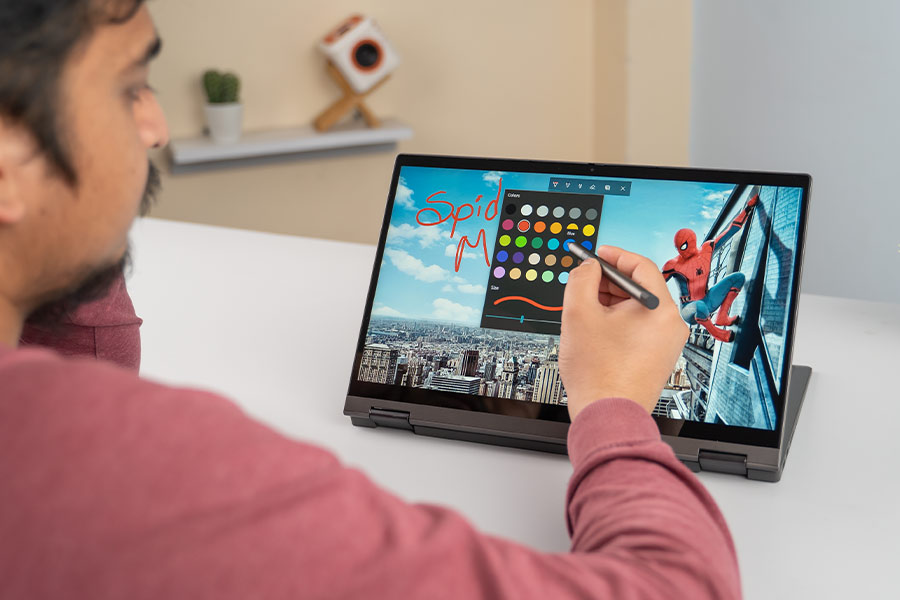
Despite being based on the older architecture, AMD says it has made some improvements on the Zen 2-based Ryzen 5000 series chips—mostly in terms of voltage control, performance levels, and integrated graphics performance.
No Zen 3 CPU
And even though last year’s 4000 series “Renoir” and these 5000 series “Lucienne” silicons conform to the same transistor layout, the company has made improvements in the manufacturing and firmware stage to enable superior performance on the newer silicons. At the end of the day, all of this feels like an unnecessarily convoluted ploy from AMD which ultimately confuses buyers of Ryzen 5000-series powered laptops.
Moving on to the core performance itself, the Ryzen 5500U handles pretty much everything you throw at it. Not high-end editing or 3D rendering workloads, but you know what I mean. Throughout my usage, the IdeaPad Flex 5 has kept up with all my requirements.
Like I mentioned earlier, I mostly used the laptop under Intelligent Cooling mode and it was pretty smooth sailing throughout all my workloads. I clocked apps like Adobe PhotoShop and LibreOffice Writer to start at 10 and 1.4 seconds on average, respectively.
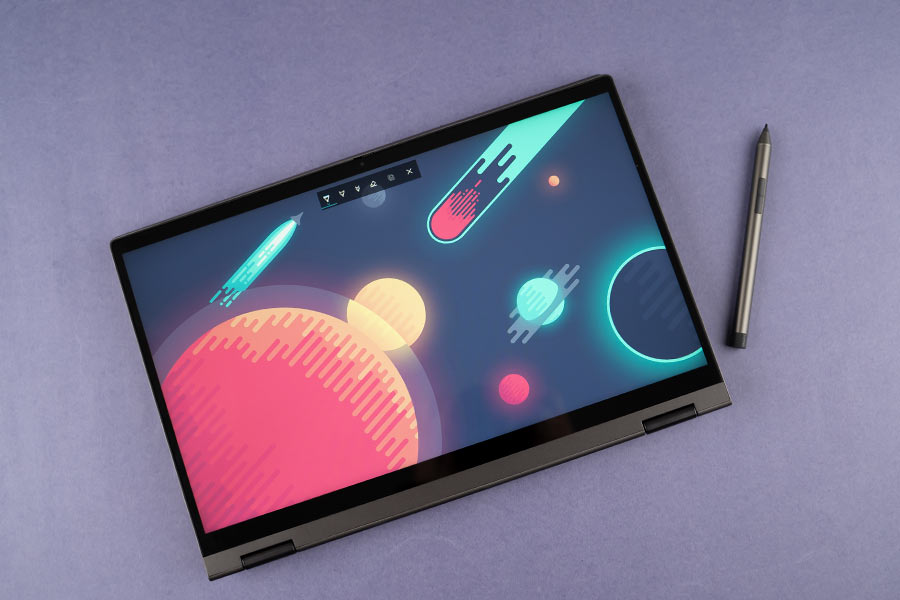
All in all, the Ryzen 5500U is a pretty competent processor even though it doesn’t enjoy the perks of Zen 3 architecture. This hexa-core CPU is the successor to Ryzen 5 4500U and there are a couple of notable head-on upgrades here. First, AMD has bumped the number of threads from 6 to 12 on the newer silicon although the base clock sees a 200MHz downgrade.
Upgraded integrated graphics
More importantly, the integrated graphics have undergone a major bump this time around. We haven’t quite been satisfied with the performance of the integrated Radeon graphics from the Ryzen 4000-powered laptops we’ve tested so far. But, things have changed. Compared to its predecessor with 6 GPU cores, the Ryzen 5500U has one more—and their clock speed has been upped to 1800MHz from 1500MHz as well.
So, relatively less demanding games like CS: GO and Valorant result in smooth gameplay with adjusted settings. By the way, I tested the games under the Extreme Performance profile that cranks the fan speed to the max.
| High | Medium | Low | |
| CS: GO | 48-50 fps | 56-58 fps | 65-68 fps |
| Valorant | 72-76 fps | 77-80 fps | 83-85 fps |
Comparatively more demanding titles like the new Knockout City Block Party gave a fairly smooth 43-45 fps gameplay under High shadow quality. While these scores read good enough for integrated graphics, the Lenovo IdeaPad Flex 5 is by no means a gaming laptop.
Can’t handle games well
After mere 10 minutes into the game, I clocked the CPU core temperature around 77ºC degrees which goes on to hit 83ºC when further pushing this silicon. And of course, the single fan setup simply can’t keep up with the rising temperature. All of this translates to an uncomfortably hot keyboard deck, especially in the left half.
So, if you wish to game on the Flex 5, hooking up a separate keyboard is almost essential. Multitasking on this laptop has been no problem either. It manages to keep things in memory quite well.
However, the RAM stick is soldered into the motherboard. So, if you decide on getting this laptop, be sure to consider your performance requirements and then carefully choose between the 8/16GB RAM variant. If 256GB of base storage isn’t sufficient, you will be able to switch it with a higher capacity M.2 PCIe SSD though. Let’s now take a look at few other benchmarks scores:
CrystalDiskMark
| Read (MB/s) | Write (MB/s) | |
| SEQ1M Q8T1 | 2479.67 | 965.89 |
| SEQ1M Q1T1 | 1748.20 | 964.51 |
| RND4K Q32T1 | 411.75 | 284.10 |
| RNK4K Q1T1 | 43.24 | 81.80 |
Cinebench R23
| CPU: Multi-Core | 7238 |
| CPU: Single Core | 1164 |
| MP Ratio | 6.22x |
Geekbench 5
| CPU: Single Core | 1094 |
| CPU: Multi-Core | 5505 |
| Compute (OpenCL) | 13296 |
Unigine Heaven
(FPS: 14.9, Score: 375, Min FPS: 5.6, Max FPS: 32.2)
| API: OpenGL | Multi-monitor: Disabled |
| Quality: High | Anti-aliasing: x2 |
| Tessellation: Extreme | Fullscreen: Yes |
| Stereo 3D: Disabled | Resolution: System |
GFXBench
| 1440p Aztec Ruins OpenGL (High Tier) Offscreen | 21.2291 fps |
| 1080p Car Chase Offscreen | 50.1327 fps |
| 1080p Manhattan 3.1 Offscreen | 60.2856 fps |
| 1080p ALU 2 Offscreen | 281.772 fps |
| 1080p Driver Overhead 2 Offscreen | 80.6699 fps |
| 1080p Texturing Offscreen | 39.1182 fps |
3DMark
| Overall | Graphics | Physics | Combined | |
| Fire Strike v1.1 | 2882 | 3190 | 16885 | 972 |
| Total | Graphics | CPU | |
| Night Raid v1.1 | 12735 | 13554 | 9489 |
| Time Spy v1.2 | 1091 | 959 | 5012 |
Battery
- 52.5 Watt-hour Li-Po battery
- 65W USB-C adapter inside the box
Besides the impressive performance, the Flex 5 is a clear winner in terms of battery endurance too. Fueled by a 52.5 Whr battery, I managed to get a little over 9 hours of screen-on time at best. My usage comprised of 6-7 Chrome tabs open with brightness set at 77% and Intelligent Cooling performance profile. So, if you want a laptop that can last throughout the day, this is a great option.
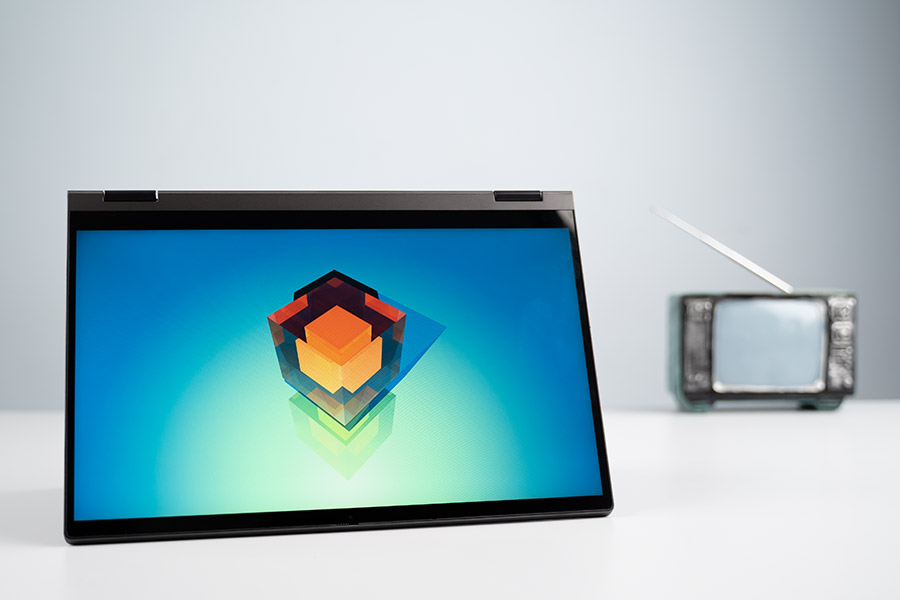
But once again, the IdeaPad Flex 5 shows its inconsistency in the battery department too. In rare instances when the laptop abruptly starts getting warm with the fan unable to cool it down, the battery life drops to below 5 hours. Anyway, the 65W power adapter takes a little over 1.5 hours to fully juice up the laptop.
Under the Lenovo Vantage app, you can also select how fast or how efficiently to fill up the battery. By enabling the “Rapid Charge” mode, Lenovo says the Flex 5 can get 2 hours of screen-on time with just 15 minutes of charge. With stable battery health in the long run in mind, there’s the “Conservation Mode” that restricts power input once the battery hits 55-60% charge level.
Conclusion
To sum up this review, the Lenovo IdeaPad Flex 5 14 is a perfect definition of a mixed bag. Powered by the Ryzen 5 5500U, its performance is stellar for the price and is, therefore, a great option to those who value raw power over everything else.
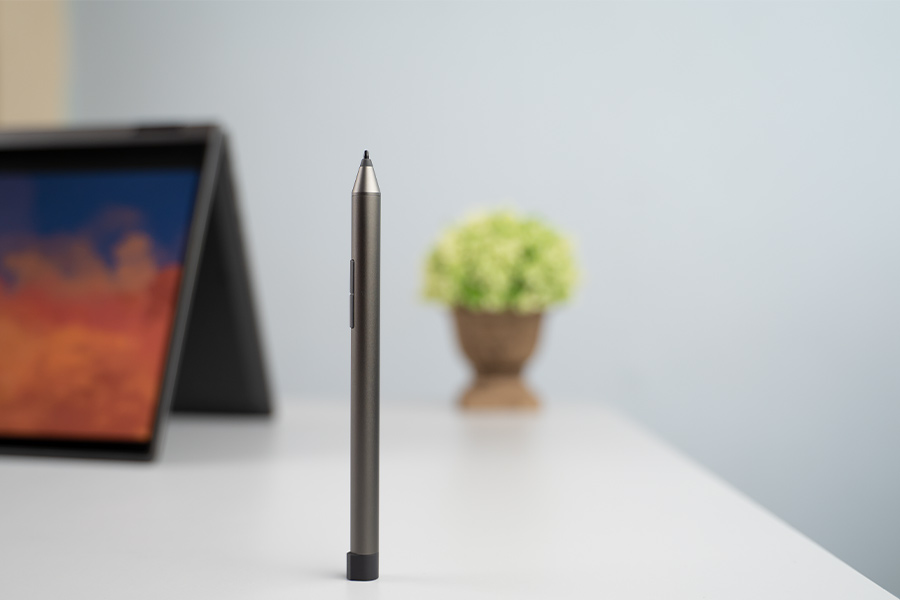
Plus, its battery is no slouch either. Add this to the fact that it is a 2-in-1 laptop, then the Flex 5’s potential utility shoots through the roof. However, its dim screen with sub-par color reproduction makes for an unappealing value proposition to those with content creation in mind. Ultimately, I’ll still recommend it to students, teachers, or business professionals who can make do with the average display.
- Watch our video review of Lenovo IdeaPad Flex 5 14.
Lenovo IdeaPad Flex 5 14 Review: Pros & Cons
Pros:
- Great performance with AMD CPU
- Can be used as a tablet as well
- Lenovo Active Pen inside the box
- Front-firing dual speaker setup
- Decent webcam, privacy shutter
- Excellent battery endurance
Cons:
- Not-so sturdy hinge mechanism
- Display doesn’t get bright enough
- Screen has a mediocre color gamut
- A relatively poor cooling solution
- RAM is soldered into the motherboard












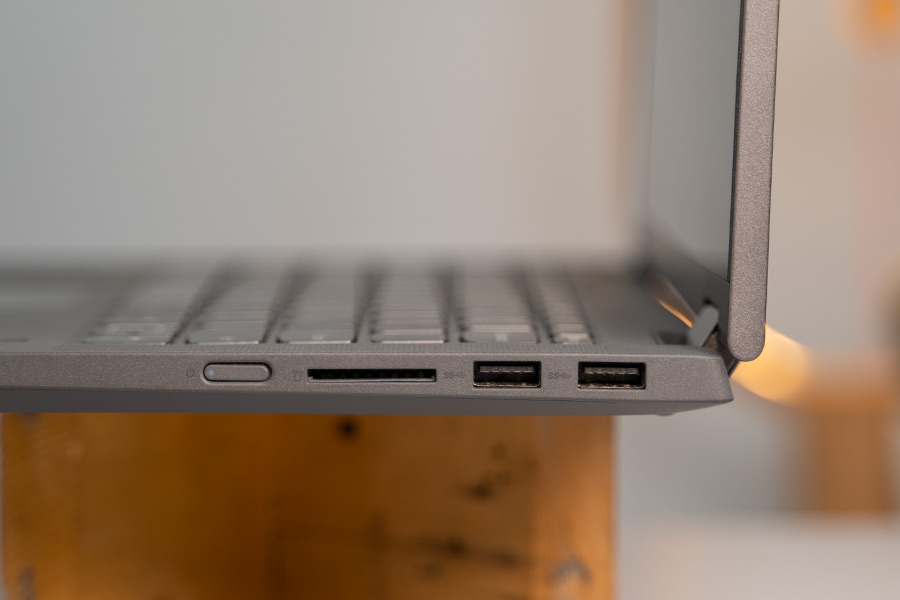
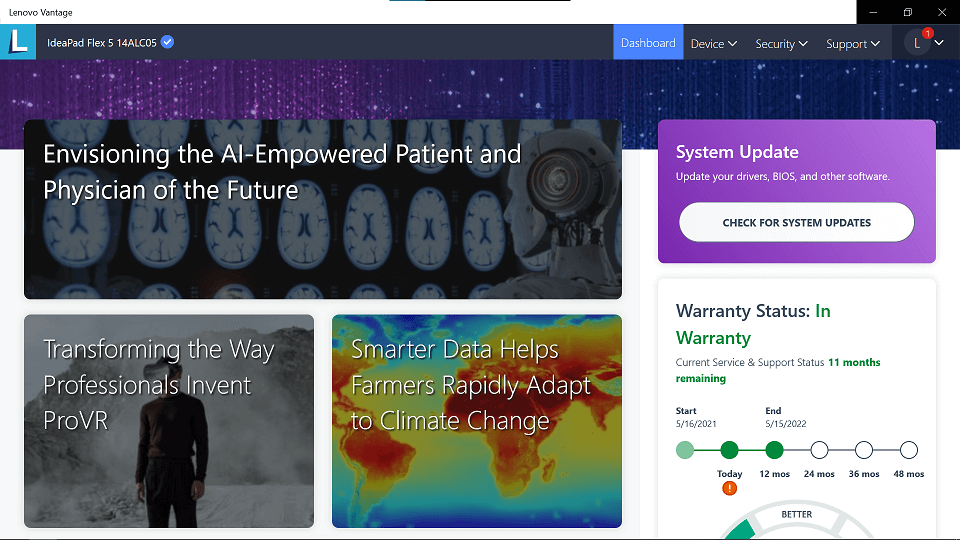
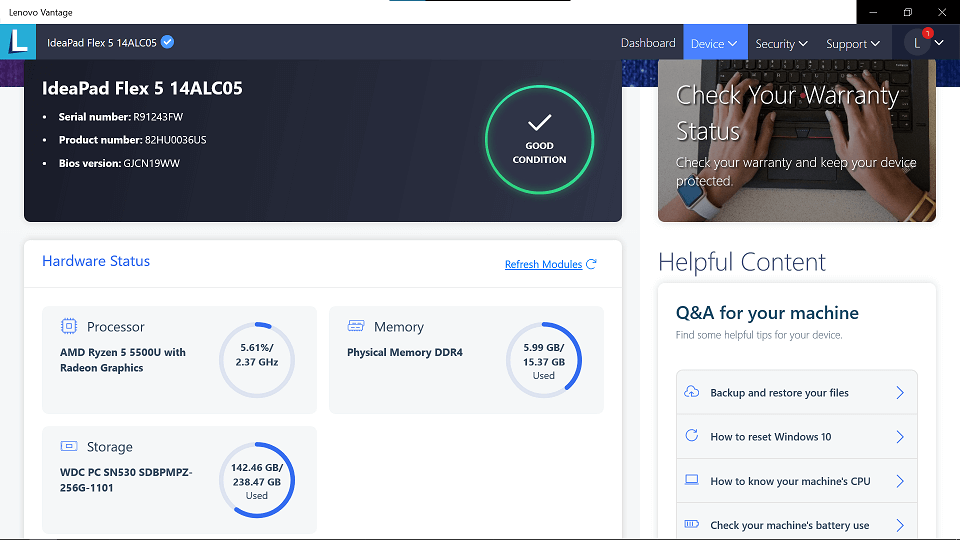

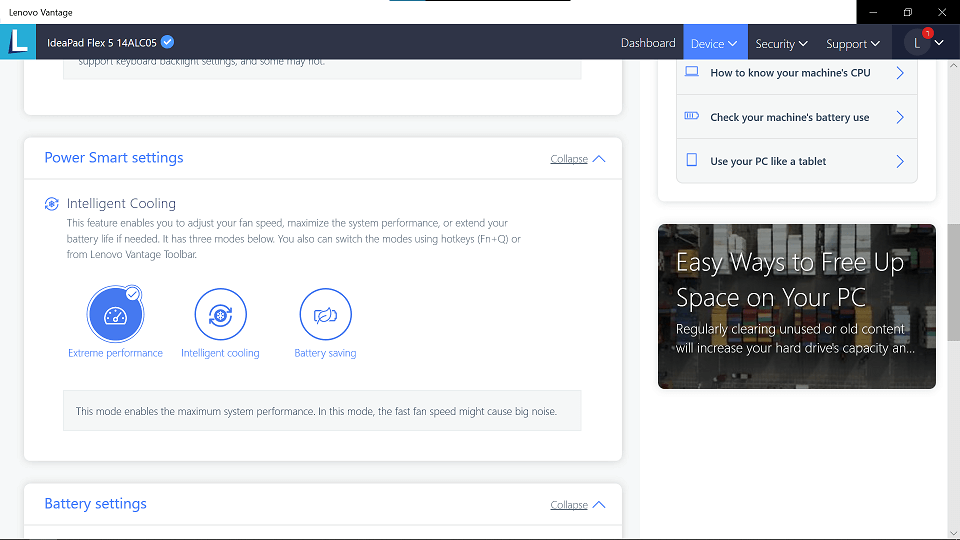
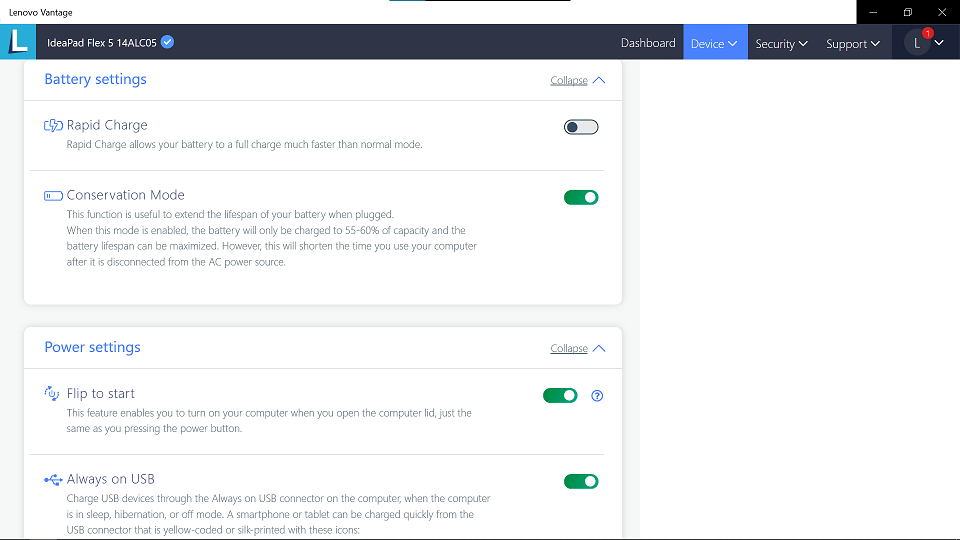







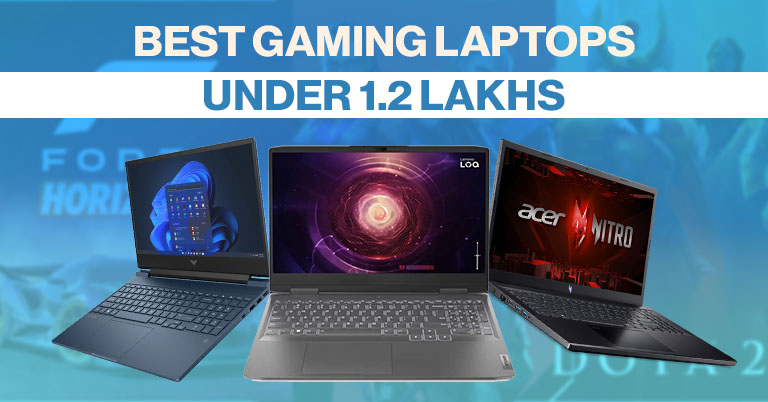

![Best Mobile Phones Under Rs. 15,000 in Nepal [Updated] Best Phones Under 15000 in Nepal 2024 Budget Smartphones Cheap Affordable](https://cdn.gadgetbytenepal.com/wp-content/uploads/2024/03/Best-Phones-Under-15000-in-Nepal-2024.jpg)
![Best Mobile Phones Under Rs. 20,000 in Nepal [Updated] Best Mobile Phones Under NPR 20000 in Nepal 2023 Updated Samsung Xiaomi Redmi POCO Realme Narzo Benco](https://cdn.gadgetbytenepal.com/wp-content/uploads/2024/01/Best-Phones-Under-20000-in-Nepal-2024.jpg)
![Best Mobile Phones Under Rs. 30,000 in Nepal [Updated]](https://cdn.gadgetbytenepal.com/wp-content/uploads/2023/12/Best-Phones-Under-30000-in-Nepal-2024.jpg)
![Best Mobile Phones Under Rs. 40,000 in Nepal [Updated] Best Phones Under 40000 in Nepal 2024 Smartphones Mobile Midrange](https://cdn.gadgetbytenepal.com/wp-content/uploads/2024/02/Best-Phones-Under-40000-in-Nepal-2024.jpg)
![Best Mobile Phones Under Rs. 50,000 in Nepal [Updated] Best Phones Under 50000 in Nepal 2024 Smartphones Midrange](https://cdn.gadgetbytenepal.com/wp-content/uploads/2024/02/Best-Phones-Under-50000-in-Nepal-2024.jpg)
![Best Flagship Smartphones To Buy In Nepal [Updated] Best Smartphones in Nepal 2024 Flagship Premium Samsung Apple iPhone Xiaomi OnePlus Honor](https://cdn.gadgetbytenepal.com/wp-content/uploads/2023/09/Best-Smartphones-in-Nepal-2024.jpg)